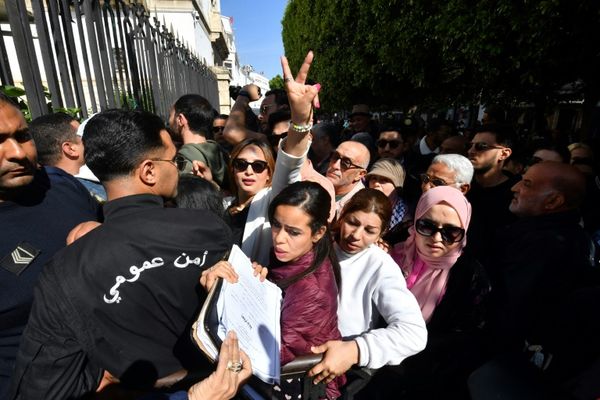
DUBLIN — In Ireland, as elsewhere, it is women who do most of the work of caring for others, at home and professionally. It is predominantly women who work in public health, teaching, and residential care. It is women who go through pregnancy, give birth to babies, raise children, and look after the sick and the elderly.
You wouldn’t think it looking around public spaces in Ireland these days, as the country prepares for the May 25 referendum on an abortion ban enshrined in law by the Eighth Amendment to the Irish Constitution. Instead, you might think that the women of Ireland were a fierce and marauding race, intent upon the slaughter of not just the unborn but also swaddled babies and thriving infants. Images of fetuses and babies are everywhere in Ireland, purportedly begging from lampposts and billboards to be spared from what has been called by more than one anti-abortion campaigner a “Holocaust.”
In Edna O’Brien’s 1964 novel, Girls in Their Married Bliss, a young Irish woman in London is married in the sacristy of a Catholic church. She is heavily pregnant. “She was in a big, floppy, striped maternity dress. … The priest didn’t look toward her stomach once.” For the past few months in Ireland, it seems like the priests have looked at little else, though the woman is often strangely absent from graphic images of the contents of her womb.
The first billboard I saw was on the wall of a corrugated iron barn on the edge of a bog in County Roscommon in the rural west of the country. On a gray February day, it loomed up, a floating moon-headed creature that glowed out against the darkness of the landscape.
The Eighth, as the amendment is now commonly known, was inserted into the Irish Constitution in 1983 at the behest of an alliance of extremist social conservatives backed by the Catholic Church in their bid to outlaw abortion from Ireland in all cases. It gives the fetus the same rights as the woman in whose womb it grows. Indeed, women feature only as a subordinate clause: “The State acknowledges the right to life of the unborn and, with due regard to the equal right to life of the mother, guarantees in its laws to respect, and, as far as practicable, by its laws to defend and vindicate that right.”
Some 67 percent of those who voted in 1983 favored the amendment. After a bitter and ugly campaign, half of the electorate stayed home. When the amendment passed, it was illegal even to offer information about abortion.
Until 1973, the church had enjoyed a “special position” in Ireland, which was not surprising given that the head of the Catholic Church in the country had been party to the drafting of the 1937 constitution. But even after the clause was removed, the church continued to play a key role in all aspects of Irish life, especially in education, health, and social policy. Catholic morality prevailed. Contraception was not legal until after 1979, and even then it was only available for “bona fide family planning” purposes.
In the 1980s, when Ireland’s head of government, or Taoiseach, launched a “constitutional crusade” to modernize Ireland and make it more pluralistic, one of the objectives was to reassure Protestant Unionists in Northern Ireland that the republic was not the Catholic theocracy they feared. However, for political reasons — due to the combined might of the church and his political enemies — he pushed for the amendment, which was entirely unnecessary since abortion was already illegal under the 19th-century law Ireland had inherited from its days as a British colony.
During the 1983 debate, the Catholic bishop of Clonfert, Joseph Cassidy, claimed that the most dangerous place for an Irish baby to be was in its mother’s womb. The anti-amendment campaign, which I supported, tried to make a more complex case. We argued that women sometimes needed to have abortions. That a woman who had been raped had a right not to bear a rapist’s child. That a woman who had a life-threatening illness might need treatment that would not allow her to continue her pregnancy. That women had the right to choose to control their fertility.
In the years that followed, all of our worst fears came true, and many more heartbreaking scenarios were played out that we had never imagined. There were suicidal pregnant children; a mortally ill woman whose body was already breaking down but who was kept alive like a human incubator because she was pregnant; the state compelled women to carry to full term babies who had died; couples had to return the cremated remains of their baby to Ireland in a jiffy bag. More recently, there was the tragic case of Savita Halappanavar, who died in 2012 of sepsis because medical staff at a Galway hospital refused to treat her, even though she was already miscarrying and the baby would not survive. Flustered, successive Irish governments introduced several further amendments, and the people voted to allow women to get information and to travel for abortions. It seemed that the priority of those who backed the amendment was to shame women and ensure abortions were not performed on the hallowed soil of Ireland.
Irish women have, of course, continued to have abortions, mostly by leaving the country and traveling to England, given that a relatively liberal abortion regime has been in place in mainland Britain since 1967. (The legislation in force in the rest of the United Kingdom was not enacted in Northern Ireland, where an equally conservative regime prevailed and continues to wield power. Indeed, on the eve of the poll, the staunchly Unionist Orange Order declared that it was urging a no vote.)
Since 1983, at least 170,000 women giving an Irish address have had abortions in British clinics and hospitals. Those who could not afford to travel, or who did not have the documents required to enter Britain, did not have this choice. Today, with abortion pills readily available online, the number has declined to around 3,000 a year. Women who returned home and had medical complications were reluctant to seek help and in some cases were turned away by doctors fearful of putting themselves at legal risk.
Until recently, successive Irish governments have shied away from the issue, ignoring critical reports from the United Nations and international human rights bodies. But the shocking and avoidable death of Halappanavar gave new momentum to feminists calling for a repeal of the amendment. Medical professionals have, crucially, begun to speak out about the dilemmas the Eighth Amendment causes them. The Catholic Church has also lost a great deal of its moral authority, not least because of a string of revelations proving that it had covered up extreme cruelty toward women and children in mother and baby homes and children’s homes. There are also ongoing reports of the church’s attempts to suppress revelations of widespread clerical sexual abuse of children.
The combination of activists’ demands, doctors’ pleas, public outrage at a mother’s preventable death, and a shifting cultural and political environment laid the groundwork for the current referendum. In 2016, the Citizens’ Assembly recommended radical change, including repeal of the Eighth Amendment to be followed by legislation for abortion in Ireland. A parliamentary committee broadly backed its recommendations. Today, unlike in 1983, the government is on the side of the feminists. The Taoiseach, Leo Varadkar of the Fine Gael party, has called for a yes vote. So has the Irish republican party Sinn Fein, which used to be vehemently anti-abortion. The Fianna Fail party, traditionally the enemy of Fine Gael but which currently informally supports Varadkar’s minority government, is divided — but its leader, Micheal Martin, says he will vote for repeal of the Eighth. Smaller parties have also backed the repeal movement.
Those campaigning to maintain the status quo are keen to suggest that they represent the true spirit of Ireland. Their posters include one that features photos of the signatories of the Irish proclamation of independence issued during the Easter Rising of 1916, with the caption: “They told us to cherish all the children of the nation equally — vote no.” The phrase is usually taken by historians to mean that the needs of Northern Irish protestants should be accommodated in the republic. The no campaign has no qualms about inaccurately appropriating the words of national heroes for its scaremongering.
Dublin and Ireland’s other cities are, on the evidence of the most recent opinion polls, going to vote yes by a considerable margin. In rural areas, the margin is smaller, and it is possible that in some western counties the “no” vote may prevail — though reports from “yes” campaigners suggest a last minute surge in their direction, as anti-abortion campaigners resort to old scare tactics. The last referendum held in Ireland led to a joyful victory for campaigners for same-sex marriage. There is nothing to celebrate about abortion. It is just a sad fact of life for women with crisis pregnancies.
As polls have shown the repeal vote maintaining a significant lead, some on the wilder fringes of the anti-abortion rights campaign have been evoking catastrophic scenarios in which Ireland becomes depopulated, baby-hating Muslims take over, and the Irish become “strangers in our own land.” Others, concerned by evidence that compassion is at play among voters, have stated in recent days that it will be possible to legislate for “hard cases” — such as pregnancy arising from rape, suicidal tendencies arising from crisis pregnancy, and pregnancies involving fatal fetal abnormalities — without repealing the constitutional ban on abortion. They are saying this despite 35 years during which there have been multiple attempts to create laws for the so-called hard cases of rape and fatal fetal abnormalities, but all have been ruled unconstitutional.
The Taoiseach, Varadkar, has firmly rejected such scare tactics. He told the Dail, the lower house of Ireland’s parliament, this week: “I would contend that it is actually our hard laws that create those hard cases. And the Eighth Amendment is too hard and forces a very hard law on Irish people and Irish women.”
Thousands of young Irish emigrants are returning home from Britain, the United States, and farther afield to vote for change. Whatever the outcome, feminism has energized the people, reached the halls of power, and made it into Ireland’s mainstream public debate at last.







